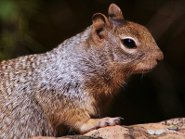 The Rock squirrel (Spermophilus variegatus) is the largest in size among all squirrels with long ears and a long tail. It is 43 to 52.5 cm (17 - 21 inches) in length and appears grayish or brown in color. It displays three colors; the head is grayish brown, shoulders are grayish, and rump is generally reddish brown, brownish, or blackish. Tail also bears the same color as the back right from top to bottom. Its braincase is not inflated but relatively flat. Its interordital region is relatively wide, upper incisors are stout, and the length of the maxillary tooth row is more than 11 mm.
The Rock squirrel (Spermophilus variegatus) is the largest in size among all squirrels with long ears and a long tail. It is 43 to 52.5 cm (17 - 21 inches) in length and appears grayish or brown in color. It displays three colors; the head is grayish brown, shoulders are grayish, and rump is generally reddish brown, brownish, or blackish. Tail also bears the same color as the back right from top to bottom. Its braincase is not inflated but relatively flat. Its interordital region is relatively wide, upper incisors are stout, and the length of the maxillary tooth row is more than 11 mm.The rock squirrel looks like the Arizona gray squirrel and to differentiate both squirrels is quite difficult. Its large size, long bushy tail, and gray color resembles only the tree squirrels which are found in New Mexico. Rock squirrels are generally found in rocks, canyon wall, rock piles, and hill slopes. Their habitat range is quite wide. They are found in marshy grounds, marshy grass, inside some hayshed, and under log cabins or fences in Arizona. They occur at 1600 ft elevation at Yuma Co., Vicksburg, San Francisco Mountains, and Coconino Co. in Arizona.
Unlike tree squirrels, rock squirrels dwell in grounds.
These squirrels mainly feed on seeds and buds of mesquite, opuntia fruit, blooms of agave, ephedra seeds, juniper berries, ribes cereum fruits, gray thorn berries, bulbs of lilies, squawbush, apricots, lupine and peaches, acorns, walnuts, grapes, cultivated wheat and corn, and hackberry. They have harassed the Supai inhabitants so much that the tribal people have chained dogs under the trees to protect their fruits. Sometimes, rock squirrels have been found eating flesh of animals as well.
There is not much known about the breeding habits of this species. It is believed that rock squirrels in the Arizona region give birth to young ones in March while those living in the cold regions may give birth in mid-May. There can be 5 to 6 babies in one litter and there can be two litters per year. The female usually nurses the babies but it is difficult for squirrels found in northern Arizona to raise two litters at a time due to a shorter season in this area.
Rock squirrels are most active in early morning and evening. In north, they hibernate in winter while in southern parts of Arizona they are active throughout the year. According to reports, these squirrels are less seen in winters and come out in abundance when the sun is shining and days are warm. In winters, they come out only to get some sunlight otherwise they are in a state of torpor but at the same time, it cannot be said that they are in hibernation.
Picture of the rock squirrrel by Tadam, licensed under GFDL
The Rock squirrel is listed as Least Concern (LR/lc), lowest risk. Does not qualify for a more at risk category. Widespread and abundant taxa are included in this category, on the IUCN Red List of Threatened Species
Namings for the rock squirrel
A young / baby of a rock squirrel is called a 'pup, kit or kitten'. The females are called 'doe' and males 'buck'. A rock squirrel group is called a 'dray or scurry'.Some facts about the
Rock squirrel
Adult weight : 0.663 kg (1.4586 lbs)
Maximum longevity : 10 years
Gestation : 30 days
Weaning : 53 days
Litter size : 4
Litters per year : 2
Weight at birth : 0.008 kg (0.0176 lbs)
Weight at weaning : 0.1 kg (0.22 lbs)

Custom Search